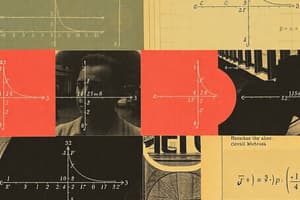Podcast
Questions and Answers
What is a linear equation?
What is a linear equation?
- A differential equation relating a function to its derivatives
- An inequality that shows a relationship between two quantities
- An equation involving trigonometric functions
- An equation written in the form a1x1 + a2x2 + ... + anxn = b (correct)
What is a system of linear equations?
What is a system of linear equations?
A collection of one or more linear equations involving the same variables.
What does the solution of the system refer to?
What does the solution of the system refer to?
A list of numbers (s1, s2, ..., sn) that makes each equation a true statement when substituted.
What is the solution set?
What is the solution set?
Two linear systems are called equivalent if they have different solution sets.
Two linear systems are called equivalent if they have different solution sets.
A system is consistent if it has at least one solution.
A system is consistent if it has at least one solution.
What is a matrix?
What is a matrix?
What is a coefficient matrix?
What is a coefficient matrix?
What is an augmented matrix?
What is an augmented matrix?
What defines the size of a matrix?
What defines the size of a matrix?
What is a basic variable?
What is a basic variable?
What are free variables?
What are free variables?
What is the Existence and Uniqueness Theorem?
What is the Existence and Uniqueness Theorem?
What does a vector equation property state?
What does a vector equation property state?
When does the equation Ax = b have a solution?
When does the equation Ax = b have a solution?
Flashcards are hidden until you start studying
Study Notes
Linear Equations and Systems
- A linear equation follows the format a1x1 + a2x2 + ... + anxn = b, where coefficients (a1, ..., an) and constant (b) are real or complex numbers.
- A system of linear equations involves one or more linear equations sharing the same variables, and is defined as a collection of such equations.
- A solution to the system is a set of numbers (s1, s2, ..., sn) that satisfies each linear equation when substituted for the variables (x1, ..., xn).
- A solution set comprises all possible solutions to a linear system.
- Two linear systems are equivalent if they share the same solution set, implying each solution from one is also a solution of the other.
Consistency and Matrices
- Consistent systems have at least one solution, while inconsistent systems have no solutions.
- A matrix is a rectangular array used to compactly record information from a linear system.
- The coefficient matrix organizes the coefficients of the variables into columns.
- An augmented matrix includes an additional column for the constants from the equations' right sides.
Matrix Characteristics
- The size of a matrix is defined by its number of rows and columns (e.g., a 3x4 matrix has 3 rows and 4 columns).
- An m x n matrix features m rows and n columns, where m and n are positive integers.
Row Operations and Equivalency
- Elementary row operations include row replacement, row interchange, and row scaling.
- Two matrices are row equivalent if one can be transformed into the other through a series of elementary row operations.
- If the augmented matrices of two systems are row equivalent, they have identical solution sets.
Key Concepts and Definitions
- Fundamental questions regarding linear systems involve checking for consistency and uniqueness of solutions.
- A leading entry is the leftmost nonzero entry of a non-zero row.
- Echelon form requires all nonzero rows to be above any rows of zeros, with each leading entry in a succeeding row positioned further to the right.
- A matrix in echelon form is described as having a "steplike" pattern in leading entries.
Row Reduction and Uniqueness
- Row reduction transforms any nonzero matrix and can yield multiple echelon forms, but reduced echelon forms are unique.
- A pivot position in a matrix corresponds to a leading 1 in its reduced echelon form, while the pivot column contains all entries associated with a pivot position.
- The row reduction algorithm systematically applies operations to achieve reduced echelon form, addressing both forward and backward phases.
Variables and Theorems
- Basic variables correlate with pivot columns, while free variables can take any values, leading to multiple solutions.
- The Existence and Uniqueness Theorem states that a linear system is consistent if the rightmost column of the augmented matrix is not a pivot column, leading to either a unique or infinite number of solutions.
- Column vectors are matrices with a single column, while equality of vectors requires corresponding entries to be equal.
- Linear combinations involve using vectors and scalars to form new vectors.
Matrix Equation and Its Conditions
- The equation Ax = b is solvable if b can be expressed as a linear combination of the columns of matrix A.
- Theorem statements describe logical equivalences regarding matrix conditions, including conditions for spanning Rm and having corresponding pivot positions.
- The row vector rule outlines how the entries in the product Ax are derived by summing products of corresponding entries from the row of A and vector x.
Studying That Suits You
Use AI to generate personalized quizzes and flashcards to suit your learning preferences.




